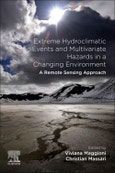Extreme Hydroclimatic Events and Multivariate Hazards in a Changing Environment: A Remote Sensing Approach reviews multivariate hazards in a non-stationary environment, covering both short and long-term predictions from earth observations, along with long-term climate dynamics and models. The book provides a detailed overview of remotely sensed observations, current and future satellite missions useful for hydrologic studies and water resources engineering, and a review of hydroclimatic hazards. Given these tools, readers can improve their abilities to monitor, model and predict these extremes with remote sensing.
In addition, the book covers multivariate hazards, like landslides, in case studies that analyze the combination of natural hazards and their impact on the natural and built environment. Finally, it ties hydroclimatic hazards into the Sendai Framework, providing another set of tools for reducing disaster impacts.
Please Note: This is an On Demand product, delivery may take up to 11 working days after payment has been received.
Table of Contents
Part I: Water cycle variables for monitoring hydroclimatic hazards: state-of-the-art and future directions 1. Precipitation 2. Terrestrial Water Storage 3. Soil Moisture 4. Water Surface Elevation 5. Evaporation 6. VegetationPart II: Remote sensing and modeling techniques for monitoring and predicting hydroclimatic hazards: Perspectives and Applications 7. Studying extreme precipitation events in mountainous regions with satellite-based precipitation products 8. Spatiotemporal patterns of precipitation concentration, aggressiveness, and seasonality in Bangladesh 9. Characterizing meteorological droughts in data scarce regions using remotely sensed precipitation 10. Recent advances in remote sensing of precipitation and soil moisture for riverine flood prediction 11. Using altimetry and optical sensors for monitoring and forecasting river discharge 12. Inundation mapping using remote sensing techniques 13. Storm Surge and Sea Level Rise: Threat to the Coastal Areas of Bangladesh 14. Hazard assessment and forecasting of landslides and debris flows: A case study in Northern Italy 15. Remote sensing-based techniques for avalanche risk assessment and forecasting








